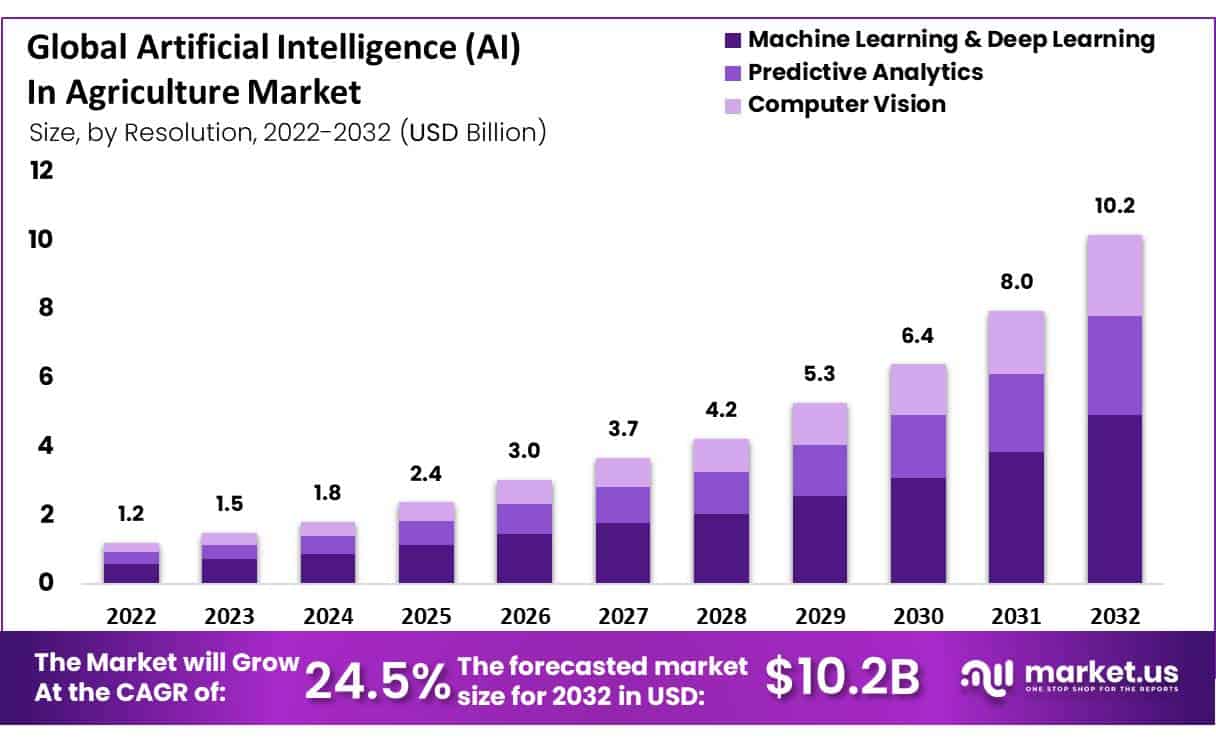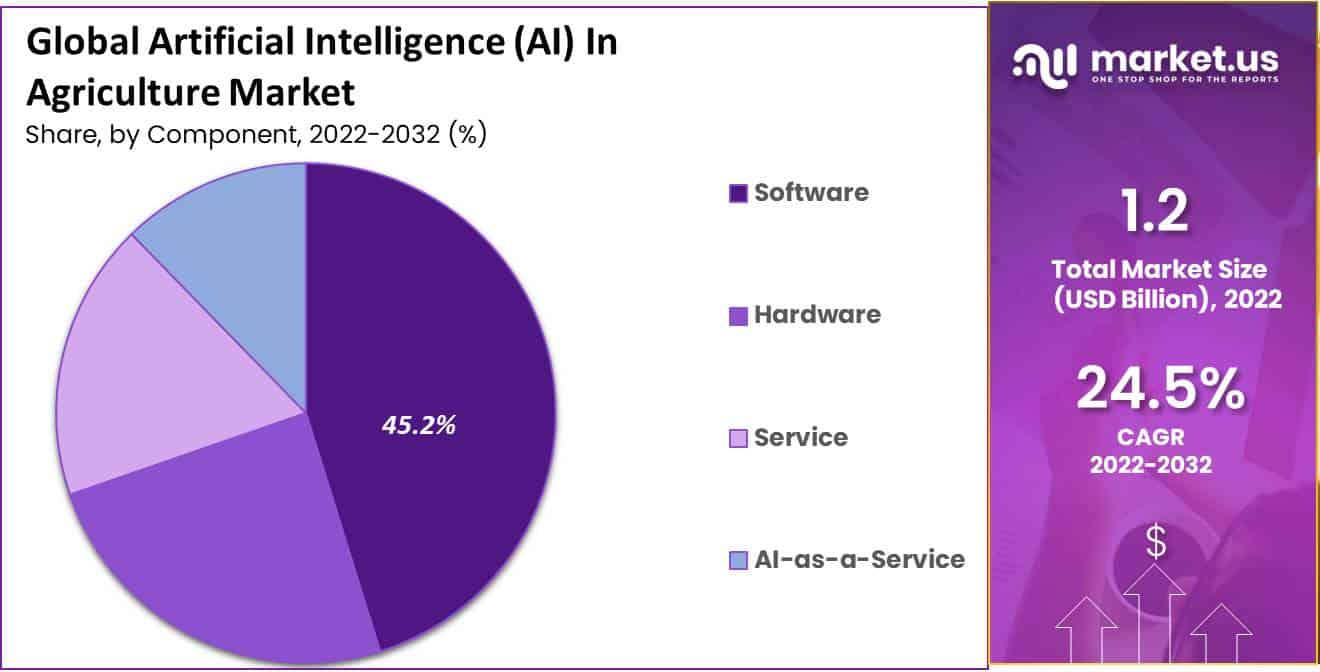New York, Feb. 06, 2024 (GLOBE NEWSWIRE) -- According to Artificial Intelligence (AI) in Agriculture Statistics, Artificial Intelligence (AI) is quickly transforming agriculture. It empowers farmers and agribusinesses to optimize practices, increase productivity, and prioritize sustainability. AI-driven precision farming efficiently manages resources like water, fertilizers, and pesticides, leading to higher yields with less environmental impact.
These AI systems also monitor crop and livestock health for early issue detection. Furthermore, AI enhances supply chain efficiency, ensuring smooth product delivery. Despite challenges like data privacy and adoption hurdles, AI integration has the potential to revolutionize agriculture, making it more efficient, sustainable, and responsive to global food needs.
Editor’s Choice
- In 2023, the global Artificial Intelligence (AI) in Agriculture market revenue reached USD 1.5 billion.
- This upward trend continues with the market expanding to USD 1.8 billion in 2024, USD 2.4 billion in 2025, and USD 3.0 billion in 2026, with each AI segment showing increased revenues.
- The software component commands the largest share, comprising 45.2% of the market, emphasizing the pivotal role of AI software solutions in transforming agricultural practices.
- Field farming continues to hold the largest share, with 61.1% in 2019 and a slightly increased 61.5% in 2024, reaffirming its dominance in the industry.
- Farm management takes the lead with a substantial 35% utilization of IoT and AI, streamlining operations and enhancing productivity.
- Precision farming and irrigation monitoring & controlling share the lead with 16% each, emphasizing the importance of precise resource management in agriculture.
- In April 2021, India and the United States launched the US-India Artificial Intelligence (USIAI) Initiative through the Indo-U.S. Science and Technology Forum (IUSSTF), a jointly funded autonomous organization. This initiative enables India to harness American AI technology to enhance food grain production in agriculture.

Global Artificial Intelligence (AI) In Agriculture Market Overview
Global Artificial Intelligence (AI) In Agriculture Market Size
- The global Artificial Intelligence (AI) in Agriculture market is on a significant growth trajectory at a CAGR of 24.5%.
- In 2022, the market generated USD 1.2 billion in revenue, and this figure is expected to steadily rise in the coming years.
- Looking ahead, the market is poised for substantial expansion, with revenues forecasted to reach USD 4.2 billion in 2028, USD 5.3 billion in 2029, USD 6.4 billion in 2030, USD 8.0 billion in 2031, and a remarkable USD 10.2 billion in 2032.

Artificial Intelligence (AI) In Agriculture Market Size - By Resolution
- The Global Artificial Intelligence (AI) in the Agriculture market is experiencing substantial growth, with various AI technologies contributing to its expansion.
- In 2022, the total market revenue reached USD 1.2 billion. Among the key AI components, Machine Learning & Deep Learning generated USD 0.6 billion in revenue, while Predictive Analytics and Computer Vision each accounted for USD 0.3 billion.
- The market is expected to reach remarkable figures by 2032, with a total revenue of USD 10.2 billion, driven by significant contributions from Machine Learning & Deep Learning, Predictive Analytics, and Computer Vision, emphasizing the growing importance of AI technologies in the agriculture sector.

Artificial Intelligence (AI) In Agriculture Market Share – By Component
- The Global Artificial Intelligence (AI) in Agriculture market exhibits a diverse landscape in terms of market share by component.
- Software commands the largest share, comprising 45.2% of the market, emphasizing the pivotal role of AI software solutions in transforming agricultural practices.
- Hardware follows closely, accounting for 24.5% of the market share, underscoring the importance of the physical infrastructure that supports AI implementations in agriculture.
- Services contribute significantly as well, with an 18.0% market share, highlighting the demand for expert services to assist in AI adoption.
- AI-as-a-Service rounds out the components with a share of 12.3%, reflecting the increasing popularity of cloud-based AI solutions that offer scalability and accessibility to agribusinesses.

Global Artificial Intelligence in Agriculture Market Share- By Farming Type
- The Global Artificial Intelligence in Agriculture market share, categorized by farming type, displays a stable distribution between 2019 and 2024.
- Field farming continues to hold the largest share, with 61.1% in 2019 and a slightly increased 61.5% in 2024, reaffirming its dominance in the industry.
- Livestock farming follows, accounting for 18.1% in 2019 and showing a modest rise to 19.1% in 2024, indicating a gradual but steady expansion in this sector.
- Indoor farming maintains a share of 15.2% in 2019, slightly decreasing to 15.0% in 2024, remaining a significant segment in AI adoption.
- Lastly, other farming types represented 5.6% in 2019, experiencing a slight decline to 4.4% in 2024, reflecting a minor shift in focus within the agricultural AI landscape.

Use of IoT and AI in Precision Agriculture
- The integration of the Internet of Things (IoT) and Artificial Intelligence (AI) technologies has significantly impacted various aspects of precision agriculture activities.
- Farm management takes the lead with a substantial 35% utilization of IoT and AI, streamlining operations and enhancing productivity.
- Weather forecast systems follow closely, representing 20% of the application, enabling farmers to make informed decisions based on real-time weather data.
- Agriculture learning and information systems contribute 15%, promoting knowledge sharing and continuous improvement in farming practices.
- Pest control stands at 13%, utilizing IoT and AI for efficient monitoring and prevention.
- Crop market management captures 10%, aiding in market analysis and strategic decision-making.

IoT Agriculture Applications
- Internet of Things (IoT) applications in agriculture encompass a wide range of functions, each contributing to the enhancement of farming practices.
- Precision farming and irrigation monitoring & controlling share the lead with 16% each, emphasizing the importance of precise resource management in agriculture.
- Soil monitoring follows closely at 13%, ensuring optimal soil conditions for crop growth.
- Temperature and humidity monitoring hold 12% and 11%, respectively, aiding in climate control and crop health assessment.
- Animal monitoring & tracking, also at 11%, facilitates livestock management and welfare.
- Water monitoring & controlling is at 7%, helping in efficient water resource utilization.
- Air monitoring and disease monitoring each account for 5%, addressing environmental and health factors.

Farming Activities and AI Companies
- In the realm of farming activities, Artificial Intelligence (AI) has made substantial strides, offering innovative solutions through various companies.
- For weed control, Blue River Technology has pioneered AI-driven systems.
- Regarding harvesting and packaging, Harvest CROO Robotics leads the way with automation.
- Diagnosing pests and soil defects finds its solution in PEAT's AI technologies, while soil analysis benefits from Trace Genomics' expertise.
- Crop health monitoring is efficiently handled by SkySquirrel Technologies, ensuring the well-being of crops.
- Blue River Technology also makes an appearance in lettuce thinning, further showcasing its AI prowess.
Key AI in Agriculture Initiatives
- In April 2021, India and the United States launched the US-India Artificial Intelligence (USIAI) Initiative through the Indo-U.S. Science and Technology Forum (IUSSTF), a jointly funded autonomous organization. This initiative enables India to harness American AI technology to enhance food grain production in agriculture.
- In December 2023, China unveiled its first vertical plant factory in Chengdu, Sichuan Province, developed by the Institute of Urban Agriculture (IUA) at the Chinese Academy of Agricultural Sciences (CAAS). This innovative system employs AI-driven robots that can efficiently grow and harvest lettuce in just 35 days.
- In June 2022, Israel initiated a strategic effort to integrate satellite technology and AI into agriculture. With the collaboration of the Israel Space Agency, a satellite will be used to map agricultural regions and determine suitable crop cultivation areas.
Smart Agriculture Investment Statistics
- Investments in smart agriculture have been steadily increasing in recent years.
- In 2017 and 2018, funding stood at USD 1.1 billion, with 267 and 351 deals, respectively.
- However, there was a noticeable uptick in 2019, reaching USD 1.7 billion across 376 deals.
- The momentum continued to grow in 2020, as the sector attracted USD 3.4 billion in funding through 422 deals.
- In the most recent data from 2021, smart agriculture investments surged to USD 4.9 billion across 440 deals.
- The Smart farming market accounted for USD 19.5 billion and is expected to reach USD 53 billion in 2032. At a CAGR of 10.5%.

Smart Agricultural Equipment and Artificial Intelligence
- Drones have gained significant popularity in agritech for crop assessment, imaging, and data collection tasks.
- Agricultural drone usage constitutes 11% of the global drone market.
- The market values for all aspects of smart crop monitoring are anticipated to experience growth by 2027, particularly in automation and robotics, which are projected to surpass 1.1 billion U.S. dollars. Autonomous machinery finds applications in tasks like plant spraying, harvesting, and planting.
- The global market for autonomous harvesting equipment is expected to reach approximately 7.7 billion U.S. dollars by 2027.
- While spraying equipment currently holds the largest market share, it is estimated to grow by around 240% from 2021 to 2027.
Related Reports in Agricultural Industry:
- E-commerce of Agricultural Products Market size is expected to be worth around USD 90.1 Bn by 2033, growing at a CAGR of 8.4%.
- Agricultural Enzymes Market size is expected to be worth around USD 623 Million by 2033, from USD 319.7 Million in 2023
- Agricultural fumigants market size is expected to be worth around USD 3.5 billion by 2033, from USD 2.2 billion in 2023, at a CAGR of 4.9%
- Agricultural Adjuvant market size is expected to be worth around USD 6.2 billion by 2033, from USD 3.9 billion in 2023, at a CAGR of 4.8%
- Agricultural films market size is expected to be worth around USD 21.2 billion by 2033, from USD 11.7 billion in 2023, at a CAGR of 6.1%
- Agricultural Biotechnology Market Size was valued at US$ 111 billion in 2022 and is expected to reach around US$ 232 Billion by 2032.
- Agricultural Films and Bonding Market was worth USD 8,502 million in 2021. It is expected to grow at a 4.9% CAGR.
About Us:
Market.us Scoop, the premier source for comprehensive, accurate, and unbiased statistics in the rapidly evolving domains of technology, automotive, artificial intelligence, and beyond. Our mission is to empower you with the data and insights you need to make well-informed decisions, stay ahead of the curve, and drive innovation.
Founded in 2017, Market.us Scoop is the brainchild of a group of passionate data enthusiasts, industry experts, and storytellers who understand the transformative power of data. With backgrounds in data science, journalism, and research, our team is dedicated to demystifying complex subjects and making them accessible to all.
At Market.us Scoop, we recognize the importance of data integrity and strive to provide you with the most up-to-date, reliable, and relevant information. We meticulously gather and analyze data from an extensive network of reputable sources, ensuring that our statistics meet the highest standards of accuracy and credibility. Our in-depth reports cover a wide range of topics, including emerging technologies, market trends, consumer behavior, industry analysis, and much more.
